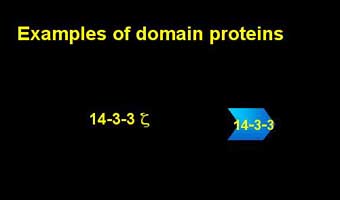Domain binding and function
14-3-3 proteins are 30 kDa polypeptides with nine
closely related members in mammals. They are also found in plants
and fungi. They are involved in regulating various pathways
including signal transduction, apoptosis and passage through the cell
cycle. 14-3-3 proteins form homo- and hetero-dimeric cup-like structures
that bind to discrete phosphoserine-containing motifs. In some
instances, 14-3-3 proteins appear to export their binding partners from
the nucleus to the cytoplasm in a phosphorylation- and Crm1-dependent
manner.

Binding examples
14-3-3 Protein
|
Binding partner
|
Function
|
|
Cdc25 tyrosine phosphatase |
Cell cycle regulation |
|
BAD (Bcl-XL binding partner) |
Regulation of apotosis |
|
c-Raf Ser/Thr Kinase |
Regulation of kinase activity; Signal
transduction |
|
PKC Ser/Thr Kinase |
Signal transduction |
|
MEKK1,2,3 Ser/Thr Kinase |
Signal transduction |
|
|
|
|